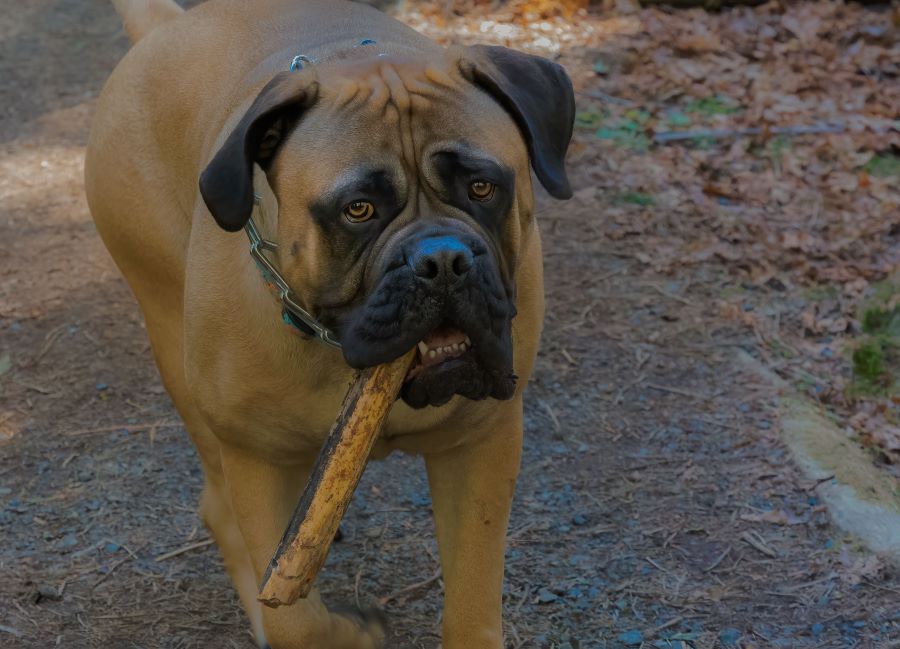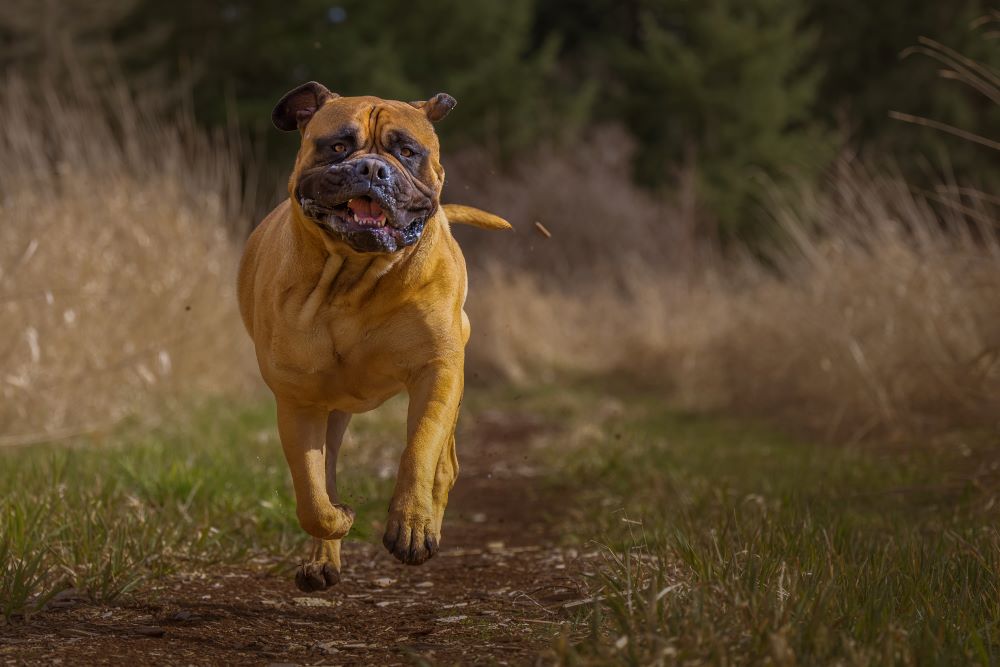Get Pet Insurance for your Cat & Dog

Zero
Documentation
Quick
Claim Process
Affordable
Premium
Terms and conditions apply*
- {{species}}
- {{indoorOutdoor}}
- {{suminsured}}
Bullmastiff Dog Breed Characteristics & Information

The Bullmastiff, often known as the 'gentle giant' of the canine world, captivates dog enthusiasts with its imposing presence and gentle demeanour. This breed, recognised for its loyalty and protective instincts, has a rich history and a range of characteristics that make it unique.
In this article, we will explore their characteristics, care requirements, training needs, and health considerations.
What is the Origin of the Bullmastiff Dog?
The Bullmastiff's roots trace back to 19th-century England, where gamekeepers sought a breed that combined the strength of the Bulldog with the speed and agility of the Mastiff. The result was the Bullmastiff, initially bred to guard estates from poachers.
They have a gentle disposition with their family members, especially children, showcasing an endearing mix of strength and tenderness. This makes them a good family dog, but not for a first-time owner, due to their high energy level and powerful physique.
What are the Characteristics of Bullmastiff Dogs?

It is necessary to understand the characteristics of Bullmastiff dogs in order to fully appreciate their unique qualities. Their characteristics include:
- Lifespan: On average, Bullmastiffs live around 8 to 11 years, with proper care and attention contributing to a longer, healthier life.
- Height: Standing between 63.5 to 68.5 cm., Bullmastiffs exhibit a powerful and muscular build.
- Colour: Their colour can vary, with shades of fawn, red, or brindle being common. A distinctive black facial mask enhances their regal appearance.
- Weight: Male Bullmastiffs typically weigh between 50-59 kg, while females range from 45-54 kg.
- Behaviour and Personality: They have a gentle and affectionate nature and are loyal family guardians. Their attitude is suitable for children and other pets.
- Living Conditions: Since bullmastiffs are indoor dogs, they cannot be left outdoors for extended periods of time, particularly in the summer heat and humidity.
- Coat: Their short, dense coat requires minimal grooming, making them relatively low-maintenance in the grooming department.
- Breed Group: Bullmastiffs belong to the Working Group, a classification that reflects their historical role as working dogs, particularly in guarding and protection.
- Temperament: Bullmastiffs are known for their courage and reliability. Give them proper training and socialization to foster a well-behaved and balanced temperament.
How to Train Bullmastiff Dogs?

Bullmastiffs are quick learners, which makes it easy to train them. Early training and consistent guidance are key elements in shaping their behaviour.
- Early Training and Socialisation: Start training and socialisation early to ensure they grow into well-mannered adults. Expose them to various environments, people, and other animals.
- Obedience Training: To manage their size and strength, obedience training must be done consistently. Control depends heavily on commands such as come, sit, and stay.
- Agility Training: Train your Bullmastiff dogs in agility to keep them both mentally and physically active. This helps them stay at a healthy weight and improves their general health as well.
- Scent Work and Tracking: Leverage their exceptional sense of smell through scent work and tracking activities. This taps into their innate abilities and provides a fulfilling outlet for their natural instincts.
- Rewards: Positive reinforcement, such as treats and praise, is key to motivating Bullmastiffs during training sessions. They respond well to rewards and thrive on the encouragement of their owners.
- Clear Guidance: Bullmastiff dogs require clear guidance and consistent rules. Set boundaries, give guidance that is clear and consistent, and build mutual respect and trust.
What are the Health Problems with Bullmastiff Dogs?
Bullmastiff dogs are healthy, but if they are not given proper care while getting older, they are prone to many health conditions. Here are five common health problems in Bullmastiff:
- Bloating Condition: Bloat, or gastric torsion, is a serious concern for Bullmastiff dogs. Feed them smaller, more frequent meals, and avoid vigorous exercise immediately after eating.
- Cancer: Certain cancers, including mast cell tumours, osteosarcoma, and lymphoma, are prevalent in Bullmastiffs. Regular veterinary check-ups and early detection are critical.
- Kidney Failure: Monitor kidney function through regular blood tests, as Bullmastiffs can be prone to kidney failure. Adequate hydration and a balanced diet contribute to kidney health.
- Entropion: Entropion, a condition where the eyelid rolls inward, can affect Bullmastiffs. Surgical intervention may be necessary to correct this issue and prevent discomfort.
- Hypothyroidism: Keep an eye on symptoms like lethargy and weight gain, as Bullmastiffs are susceptible to hypothyroidism. Regular thyroid screenings aid in early detection and management.
- Hip Dysplasia: Like many large breeds, Bullmastiff dogs may develop hip dysplasia. A well-balanced diet, controlled exercise, and weight management contribute to joint health.
How to Take Care of Bullmastiff Dogs?
Bullmastiffs are low-maintenance dogs, but they do have basic needs; it involves creating a nurturing environment that supports their overall well-being.
- Diet and Nutrition: Their diet should include ground beef, brown rice, carrots, meat, bone, and some plant-based ingredients.
- Feeding: Feed puppies several small meals and stick to two meals a day for adult dogs to avoid overloading their digestion.
- Grooming: Despite their short coat, Bullmastiffs shed, especially during seasonal changes. Weekly brushing helps minimise loose hair and keeps their coat healthy.
- Exercise: They love active walks and playing outside, but it's important to have strong fences to keep them and other animals from coming into their space.
- Overheating: Bullmastiffs' small muzzles make them prone to overheating. Avoid strenuous exercise in hot weather and provide ample shade and water.
- Slobber Care: Having a towel close by is advised because bullmastiff dogs are known to slobber.
Bullmastiff is a majestic and loyal companion with a rich history and a unique set of characteristics. Understanding their characteristics, from lifespan and height to behaviour and living conditions, provides a solid foundation for responsible ownership. Training these majestic dogs enhances the bond with their owners and ensures a harmonious coexistence.












